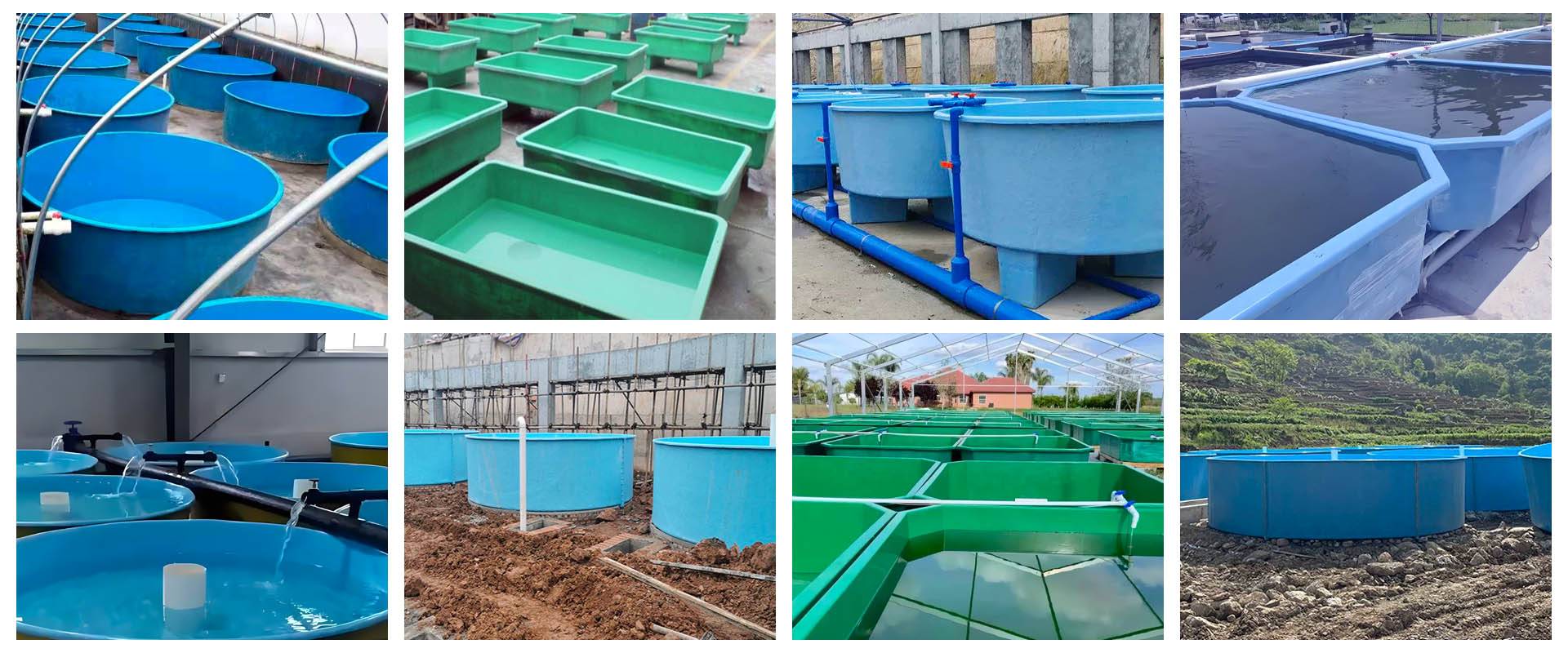How FRP Fish Tank Reduces Waste and Maintenance Costs
Fiberglass Reinforced Plastic (FRP) fish tanks offer significant advantages in reducing both waste
and ongoing maintenance costs compared to traditional materials like concrete, wood, or metal. Here’s how:
1. Superior Surface Finish Reduces Waste Accumulation
- Smooth, Non-Porous Gel Coat: FRP tanks are lined with a seamless, food-grade gel coat that creates an extremely smooth interior surface. This prevents organic waste (uneaten feed, fish feces, biofilm) from adhering and accumulating in cracks or pores, which is common in rougher concrete tanks.
- Efficient Self-Cleaning (Especially in Round Tanks): The smooth surface, combined with the hydrodynamic design of round FRP tanks, promotes a strong vortex or circular water flow. This natural current continuously pushes solid waste toward the central drain, significantly reducing the need for manual scrubbing and minimizing areas where waste can stagnate and decompose.
- Reduced Biofouling: The non-porous surface is less hospitable to algae and bacterial slime buildup, leading to cleaner water and less frequent deep cleaning cycles.
2. Durability and Longevity Minimize Replacement Waste & Costs
- Corrosion and Rot Resistance: Unlike metal tanks that rust or wooden tanks that rot, FRP is highly resistant to corrosion from saltwater, freshwater, and the chemicals used in aquaculture. This eliminates the waste associated with replacing degraded tanks and the associated labor and downtime costs.
- Impact and Weather Resistance: FRP is strong and resilient, withstanding impacts, UV degradation, and temperature fluctuations better than many alternatives. This extends the tank’s operational life for decades, drastically reducing the long-term cost of ownership and the environmental waste from frequent replacements.
- No Leaching: High-quality FRP with proper gel coating does not leach harmful substances into the water, preventing contamination and the need for corrective treatments or water changes solely due to tank material issues.
3. Lower Maintenance Requirements Cut Labor and Supply Costs
- Easy and Quick Cleaning: The smooth surface allows for rapid cleaning with minimal effort. High-pressure washing or simple wiping is often sufficient, drastically reducing the time, labor, and cost associated with maintenance crews.
- Reduced Need for Harsh Chemicals: Because waste doesn’t cling and biofouling is minimized, there’s less reliance on strong acids, alkalis, or biocides for cleaning. This lowers chemical procurement costs and reduces the environmental impact of chemical runoff.
- Fewer Repairs: The robust nature of FRP means leaks, cracks, and structural failures are rare. This eliminates the recurring costs and downtime associated with repairing concrete cracks, patching metal tanks, or replacing rotted wood.
4. Optimized Water Management Reduces Water and Treatment Waste
- Tighter Water Quality Control: The efficient removal of solids via the central drain system means water stays cleaner for longer. This can reduce the frequency and volume of water exchanges needed, conserving water resources and the energy/costs associated with pumping and heating new water.
- Improved System Efficiency: Clean tanks with minimal biofilm support better nitrification and overall water quality stability. This reduces stress on fish, lowers disease incidence (and thus medication costs), and improves feed conversion ratios (less wasted feed).
5. Design Efficiency Reduces Operational Waste
- Precise Manufacturing: FRP tanks are molded to exact specifications, ensuring optimal dimensions for water flow and space utilization. This reduces wasted space and ensures the system operates at peak efficiency.
- Integrated Features: Drains, overflows, and fittings can be seamlessly integrated during manufacturing, minimizing potential leak points and the need for aftermarket modifications that can create inefficiencies.
In Summary: FRP fish tanks reduce waste and maintenance costs through a combination of superior material properties (smoothness, durability, corrosion resistance) and efficient design (hydrodynamics, integrated features).

Inquiry please contact:
Email : cn@chinaestop.cn
Whatsapp✆:+86 15350598856
Web: www.chinaestop.cn
————————————————————————————————————————
“ Wish to be your best partner in China! Welcome to visit our company”
